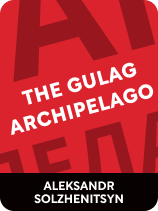

This article is an excerpt from the Shortform book guide to "The Gulag Archipelago" by Aleksandr Solzhenitsyn. Shortform has the world's best summaries and analyses of books you should be reading.
Like this article? Sign up for a free trial here.
What was life in a gulag like? What was the worst part? How effective were the attempts to fight back?
Throughout The Gulag Archipelago, Aleksandr Solzhenitsyn emphasizes that the worst aspect of imprisonment was not the brutal conditions or mistreatment—but its inherent hopelessness. The only thing prisoners could focus on was survival, and this, again, often required them to steal from and abuse others.
Continue reading to learn about life in a gulag from Solzhenitsyn’s perspective.
Life in a Gulag
As a prisoner himself, Solzhenitsyn can speak to what life in a gulag was like. Prisoners’ lives weren’t valued, he explains, and there were no avenues for early release or reconsideration of a case. Attempts at protest usually failed, either because the camp guards didn’t care about the prisoners’ well-being or because the prisoners had no public forum in which to make their grievances known.
For example, while hunger strikes attracted attention in prisons all over the world in the 20th century, they almost always failed in Soviet prisons because no one outside the prison knew if a prisoner was starving and no one inside the prison cared. All a hunger strike would do was make the prisoner even weaker.
(Shortform note: Solzhenitsyn’s point about the ineffectiveness of these hunger strikes is a common critique made of nonviolent protest: that it requires an audience who already cares, at least somewhat, about the lives of the protesters. Nonviolent protest tends to fail in instances where the protesters are totally dehumanized or the government can make their protest invisible to the general public. Even in cases of hunger strikes outside the Soviet Union, poorly publicized ones fizzled out whereas well-publicized ones succeeded in their goals.)
The only methods of resistance that did have any effect were work strikes or outright violent takeovers of the camp by prisoners. However, such protests eventually collapsed, either because the prisoners were too weak to continue resisting or because the military intervened to murder the strikers. In the end, the labor prisoners provided was not significant enough for the state to serve as an effective bargaining chip, and camp authorities would rather kill a few prisoners to keep the rest in line than concede anything to them.
(Shortform note: While Solzhenitsyn mainly discusses the Kengir Rebellion of 1954, similar uprisings occurred at the Vorkuta and Norilsk camps the previous year, shortly after the death of Joseph Stalin. Modern studies of these strikes argue that they were as successful as they were because the prisoners were well-organized and politically informed—they formed groups around shared nationality or military experience, circulated newspapers and pamphlets arguing for better treatment, and kept one another housed and fed during the months they operated independently.)
According to Solzhenitsyn, what would have made the biggest difference for prisoners in these cases was some form of transparency. If free citizens knew the extent of the abuses taking place in prison and the prisoners could count on their attempts at protest being recognized and publicized on the outside, they might have been able to work together to demand change. The Soviet government’s ability to control the flow of information was so significant because it kept the people ignorant of their most powerful tool of resistance—their numbers.
| Repressing People in a Supposedly People-First System As a political system, communism is supposed to advance the needs of the people, particularly the working class, by sharing everything—food, housing, goods, and so on—equally among them. Authoritarian communist states use this same rhetoric even as they crush attempts by “the people” to set up democratic structures or voice resistance. The Soviet Union managed this cognitive dissonance by substituting “the Party” for “the people.” The Party supposedly represented the people’s best interests, even as in practice it was controlled by a few elites. Any decision the Party made was spun as representing the will of the people, while attempts by individuals to stand against it were attacks on the people. This narrowed the definition of who counted as “people” to only the most loyal and obedient citizens. |

———End of Preview———
Like what you just read? Read the rest of the world's best book summary and analysis of Aleksandr Solzhenitsyn's "The Gulag Archipelago" at Shortform.
Here's what you'll find in our full The Gulag Archipelago summary:
- A book that was banned for exposing human rights abuses to the world
- A work of historical nonfiction that describes life in Soviet prison labor camps
- How the Soviet government used violence, paranoia, and repression to control their citizens






